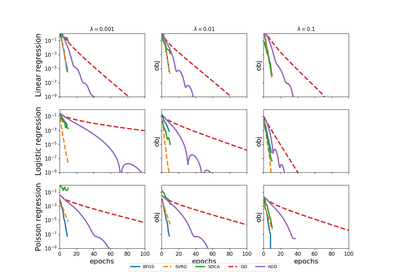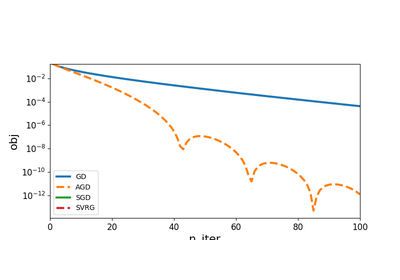tick.solver.AGD¶
-
class
tick.solver.AGD(step: float = None, tol: float = 1e-10, max_iter: int = 100, linesearch: bool = True, linesearch_step_increase: float = 2.0, linesearch_step_decrease: float = 0.5, verbose: bool = True, print_every: int = 10, record_every: int = 1)[source]¶ Accelerated proximal gradient descent
For the minimization of objectives of the form
\[f(w) + g(w),\]where \(f\) has a smooth gradient and \(g\) is prox-capable. Function \(f\) corresponds to the
model.lossmethod of the model (passed withset_modelto the solver) and \(g\) corresponds to theprox.valuemethod of the prox (passed with theset_proxmethod). One iteration ofAGDis as follows:\[\begin{split}w^{k} &\gets \mathrm{prox}_{\eta g} \big(z^k - \eta \nabla f(z^k) \big) \\ t_{k+1} &\gets \frac{1 + \sqrt{1 + 4 t_k^2}}{2} \\ z^{k+1} &\gets w^k + \frac{t_k - 1}{t_{k+1}} (w^k - w^{k-1})\end{split}\]where \(\nabla f(w)\) is the gradient of \(f\) given by the
model.gradmethod and \(\mathrm{prox}_{\eta g}\) is given by theprox.callmethod. The step-size \(\eta\) can be tuned withstep. The iterations stop whenever tolerancetolis achieved, or aftermax_iteriterations. The obtained solution \(w\) is returned by thesolvemethod, and is also stored in thesolutionattribute of the solver.- Parameters
step :
float, default=NoneStep-size parameter, the most important parameter of the solver. Whenever possible, this can be automatically tuned as
step = 1 / model.get_lip_best(). Iflinesearch=True, this is the first step-size to be used in the linesearch (that should be taken as too large).tol :
float, default=1e-10The tolerance of the solver (iterations stop when the stopping criterion is below it)
max_iter :
int, default=100Maximum number of iterations of the solver.
linesearch :
bool, default=TrueIf
True, use backtracking linesearch to tune the step automatically.verbose :
bool, default=TrueIf
True, solver verboses history, otherwise nothing is displayed, but history is recorded anywayprint_every :
int, default=10Print history information every time the iteration number is a multiple of
print_every. Used only isverboseis Truerecord_every :
int, default=1Save history information every time the iteration number is a multiple of
record_everylinesearch_step_increase :
float, default=2.Factor of step increase when using linesearch
linesearch_step_decrease :
float, default=0.5Factor of step decrease when using linesearch
- Attributes
model :
ModelThe model used by the solver, passed with the
set_modelmethodprox :
ProxProximal operator used by the solver, passed with the
set_proxmethodsolution :
numpy.array, shape=(n_coeffs,)Minimizer found by the solver
history :
dict-likeA dict-type of object that contains history of the solver along iterations. It should be accessed using the
get_historymethodtime_start :
strStart date of the call to
solve()time_elapsed :
floatDuration of the call to
solve(), in secondstime_end :
strEnd date of the call to
solve()
References
A. Beck and M. Teboulle, A fast iterative shrinkage-thresholding algorithm for linear inverse problems, SIAM journal on imaging sciences, 2009
-
__init__(step: float = None, tol: float = 1e-10, max_iter: int = 100, linesearch: bool = True, linesearch_step_increase: float = 2.0, linesearch_step_decrease: float = 0.5, verbose: bool = True, print_every: int = 10, record_every: int = 1)[source]¶ Initialize self. See help(type(self)) for accurate signature.
-
get_history(key=None)¶ Returns history of the solver
- Parameters
key :
str, default=NoneIf
Noneall history is returned as adictIf
str, name of the history element to retrieve
- Returns
output :
listordictIf
keyis None orkeyis not in history then output is a dict containing history of all keysIf
keyis the name of an element in the history, output is alistcontaining the history of this element
-
objective(coeffs, loss: float = None)¶ Compute the objective function
- Parameters
coeffs :
np.array, shape=(n_coeffs,)Point where the objective is computed
loss :
float, default=`None`Gives the value of the loss if already known (allows to avoid its computation in some cases)
- Returns
output :
floatValue of the objective at given
coeffs
-
set_model(model: tick.base_model.model.Model)¶ Set model in the solver
- Parameters
model :
ModelSets the model in the solver. The model gives the first order information about the model (loss, gradient, among other things)
- Returns
output :
SolverThe same instance with given model
-
set_prox(prox: tick.prox.base.prox.Prox)¶ Set proximal operator in the solver
- Parameters
prox :
ProxThe proximal operator of the penalization function
- Returns
output :
SolverThe solver with given prox
Notes
In some solvers,
set_modelmust be called beforeset_prox, otherwise and error might be raised
-
solve(x0=None, step=None)¶ Launch the solver
- Parameters
x0 :
np.array, shape=(n_coeffs,), default=`None`Starting point of the solver
step :
float, default=`None`Step-size or learning rate for the solver. This can be tuned also using the
stepattribute- Returns
output :
np.array, shape=(n_coeffs,)Obtained minimizer for the problem, same as
solutionattribute

